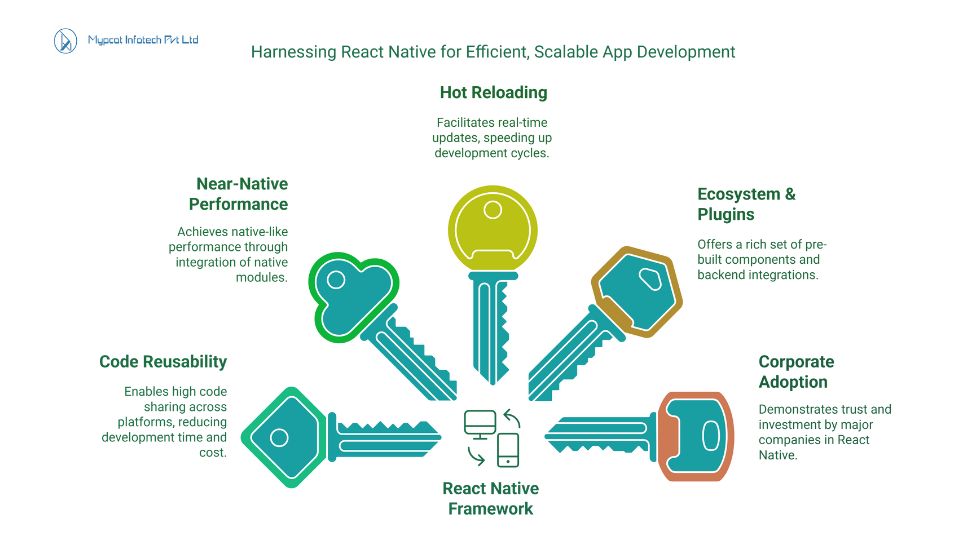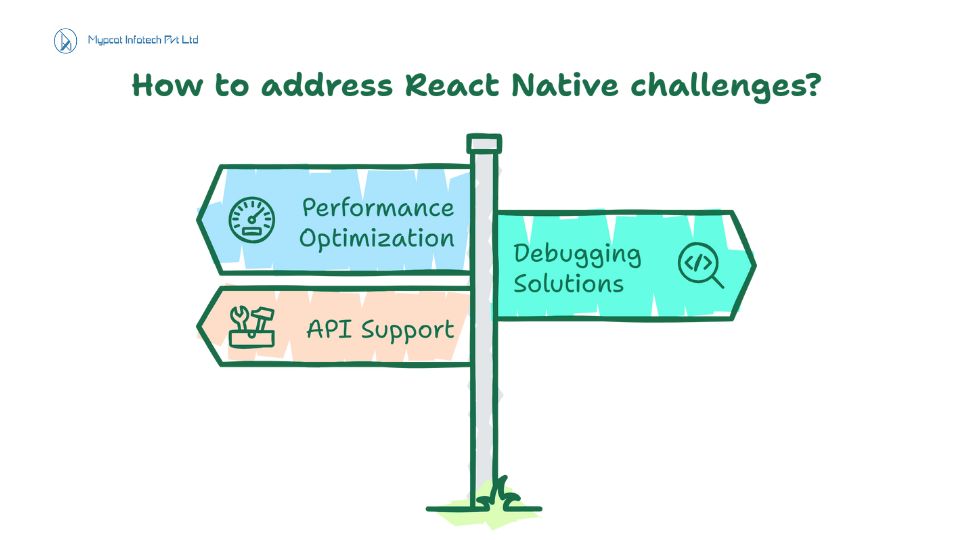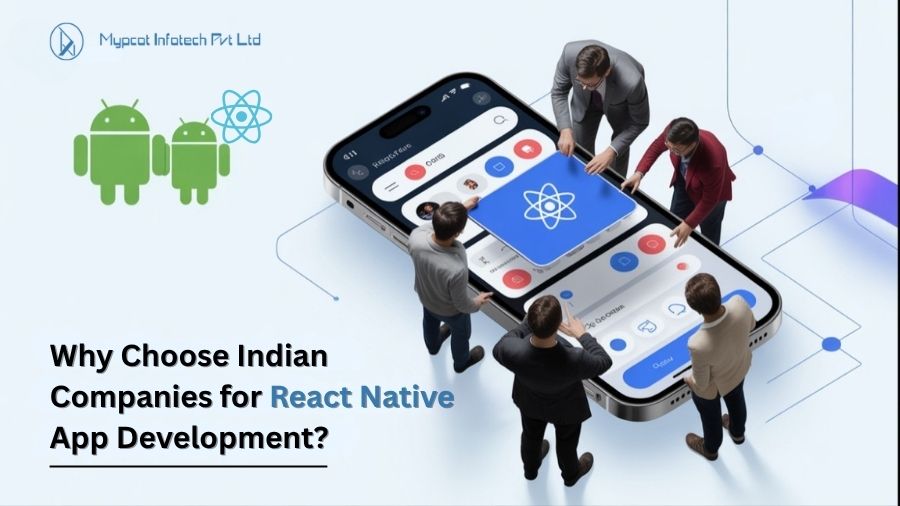Table of Contents
ToggleThe Rise of React Native in 2025
In 2025, React Native powers 14.85% of the top 500 U.S. apps. From startups to Fortune 500 giants like Walmart and Airbnb, businesses rely on this framework to unify iOS and Android development. But why? React Native’s blend of cost efficiency, near-native performance, and a single codebase makes it the go-to solution for entrepreneurs, CTOs, and developers.
For startups and SMBs, React Native slashes development costs by 30–40%. For enterprises, it ensures scalability. And for investors, it guarantees faster ROI. In this guide, we’ll break down React Native’s advantages and challenges and why partnering with a React Native app development company in India like Mypcot can future-proof your app strategy.
What is React Native? A 2025 Overview
Meta (Facebook) launched React Native, an open-source JavaScript framework, in 2015. It enables developers to build cross-platform mobile apps using a single codebase that runs natively on iOS and Android.
Key Features Driving Adoption
- Learn Once, Write Anywhere” Philosophy: Reuse up to 90% of code across platforms.
- Native-Like Performance: Uses platform-specific UI components for smooth UX.
Hot Reloading: Instantly view code changes without app restart.
Market positioning in 2025
2nd Most Popular Cross-Platform Framework (13% market share).
- According to Stack Overflow Survey 2025, 42% of developers use it.
- It powers apps like Facebook Ads Manager, Instagram, and Tesla.
Top 8 Reasons to Choose React Native for App Development

1. Cross-Platform Code Reusability: Build Once, Deploy Everywhere
- 70–90% Code Sharing: Write one codebase for iOS, Android, and the web (via React Native Web).
- Case Study: Facebook’s Ad Manager reused 87% of code between platforms.
- Cost Savings: Startups save 30–40% vs. maintaining two native teams.
2. Near-Native Performance with Native Modules
- Bridging Native APIs: Integrate platform-specific features (e.g., camera, GPS) using native modules.
- Optimized UI: Uses iOS’s UIKit and Android’s Material Design components.
- Benchmark: Walmart achieved native-like speeds post-migration to React Native.
3. Hot Reloading: Speed Up Development Cycles
- Real-Time Updates: Test UI/UX changes instantly without rebuilding the app.
- Faster Iterations: Reduces debugging time by 20% (2025 Developer Survey).
4. Thriving ecosystems and third-party plugins
- Pre-Built Components: Libraries like NativeBase and React Navigation.
- Backend Integration: Firebase, AWS Amplify, and Back4App for scalable cloud services.
- Community Support: 1M+ developers contribute to GitHub repositories.
5. Cost-effective scalability for startups and enterprises
MVP Development: Launch a minimum viable product in 8–12 weeks.
- Modular architecture: Add features like chatbots or payment gateways without overhauling the code.
- Case Study: Healthtech startup Healify scaled to 500k users with React Native.
6. Strong backing from Meta and corporate adoption
- Meta’s Investment: Regular updates (e.g., new architecture in 2023) boost performance.
- Enterprise Trust: Used by Microsoft (Skype), Tesla, and Walmart.
7. Simplified UI/UX development
- Declarative Coding: Focus on “what” instead of “how” for intuitive interfaces.
- Flexbox Layout: Responsive designs that adapt to screen sizes.
8. Future-Proof with Web & IoT Integration
- React Native Web: Extend mobile apps to browsers with 80% code reuse.
- IoT Compatibility: Build apps for smart TVs, wearables, and connected devices.
React Native vs. Competitors: Which Framework Wins in 2025?
1. React Native vs. Flutter
Factor React Native Flutter Language JavaScript (familiar to 70% of developers)Dart (steep learning curve)Performance near-native with bridges High (compiled to native code)Community1M+ GitHub contributors, 500k+ developers Use Cases Enterprise apps and MVPs UI-heavy apps (e.g., e-commerce)
Verdict: Choose React Native for faster MVP launches and Flutter for pixel-perfect UIs.
2. React Native vs. Native Development
- Cost: React Native is 50% cheaper (1 team vs. iOS + Android teams).
- Speed: Launch apps 2x faster with shared codes.
- Trade-Off: Native apps perform slightly better for AR/VR and gaming.
Top tools and backend services for React Native apps
1. Backend Solutions
- Firebase: Real-time databases, analytics, and authentication (used by Instagram).
- AWS Amplify: Scalable cloud storage and AI/ML integration.
- Supa base: Open-source alternative with PostgreSQL support.
2. Debugging and testing tools
- Flipper: Debug iOS/Android apps in real time.
- Jest: Unit testing for React Native components.
- Appium: Cross-platform automation testing.
3. UI/UX Libraries
- React Navigation: Routing and navigation for seamless flows.
- Lottie: Add complex animations without lag.
Challenges of React Native & How Mypcot Solves Them

1. Performance Limitations in Heavy Apps
- Issue: Apps with heavy animations (e.g., gaming) may lag.
- Mypcot’s Solution: Optimize with native modules (Swift/Java) and tools like Reanimated 3.
2. Debugging Complexity
- Issue: JavaScript-Native bridge errors can slow progress.
- Mypcot’s Solution: Use Flipper and strict code review protocols.
3. Limited Native API Support
- Issue: New iOS/Android features may lack React Native libraries.
- Mypcot’s Solution: Build custom native modules in-house.
Case Studies: React Native Success Stories
1. Walmart: 95% code reuse and enhanced performance.
- Challenge: Maintain separate iOS/Android apps with high costs.
- Solution: Migrated to React Native, achieving 95% code reuse and native-like speeds.
- Result: 20% faster app performance and unified team management.
2. Shine: From iOS to Android in 3 Weeks
- Challenge: Scale a mental wellness app to Android after iOS success.
- Solution: Used React Native to reuse 82% of code.
- Result: Launched on Google Play in 21 days with 1.5M+ downloads.
3. Mypcot’s Portfolio: Fintech Apps for an Indian Startup
- Challenge: Build a secure, cross-platform finance app on a $30k budget.
- Solution: Developed with React Native, Firebase, and biometric authentication.
- Result: Launched in 14 weeks with a 4.8/5 Play Store rating and 80% cost savings.
Why Partner with Mypcot, India’s Leading React Native App Development Company?
1. 60% Cost Savings vs. Western Agencies
2. Certified React Native Experts
3. Agile development and faster time-to-market
Conclusion: React Native is Your Gateway to 2025’s Mobile-First World
React Native isn’t just a framework—it’s a strategic advantage. Startups reduce costs, enterprises scale efficiently, and developers enjoy a future-proof toolkit. With Meta’s relentless updates and India’s tech talent pool, there’s never been a better time to invest.
Are you prepared to embark on a project? Partner with Mypcot, India’s top React Native app development company, for scalable, cost-effective apps that stand out. Contact Us today for a free consultation!











